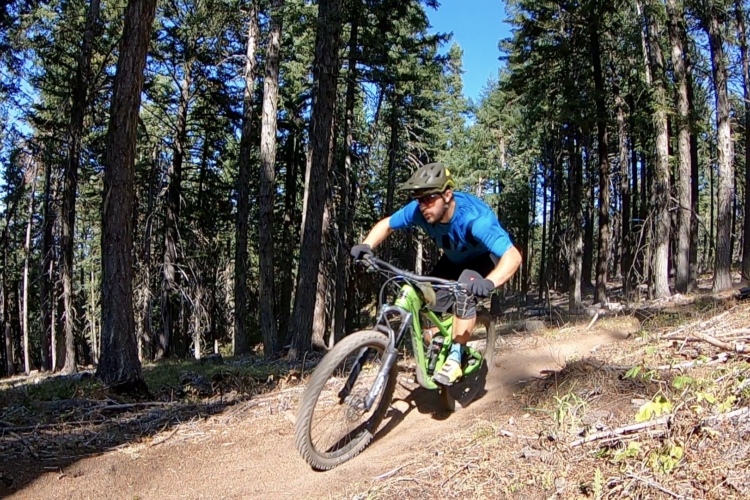Mountainbikes have run with the 26″ wheel for a long time, and not because it was the best; but because it was the only size that the first fat-tire riders could use with fat tires. They came off of ballon-tire bikes, and they ran knobby moto treads for lack of anything else. 26″ wheels aren’t bad. In fact, they work extremely well; nice, given that for the longest time that’s all there was. Fortunately (depending on how you look at it), there were always those who seeked to improve our bikes; and they refused to believe that the 26″ was the best that could be.
But now we have a plethora of choice available, and I’m sure that many riders just starting out (or those of us who are Luddites) are confused as to what is the right choice (personal wheel-politics aside).
The 26″ – Nothing really bad can be said about the standard mountainbike wheel. It does have limitations; inability to roll over large obstacles, smallish moment of inertia, & a tendancy to bog-down in sand/mud/snow. However, it’s benefits include; a mountainbike industry based on the 26″ wheel, will support/fit a wide range of rider sizes, ability to be built as strong or light as technologically possible, ability to accept a wide range of tire sizes, & is quick to accelerate.
The 29’er – The Big Wheel has proven its’ worth for offroading decades ago with the 4-wheeling truck industry. As with trucks, a larger mountainbike wheel can roll obstacles easier, will provide greater floatation through sand/muck, gives a larger tire contact-patch for better overall traction, & maintains its’ momentum at speed. But with vehicles, the design can easily be altered to fit the large wheels & tires, with little inconvienience for the driver. On mountainbikes, frames with 29″ wheels must be designed to keep the rider’s COG & standover height low, prevent tire-toe overlap, & keep the overall weight down. While manufacturers have done an admirable job of this, the 29’er is still better suited for tall riders. Frames for very short riders will not be able to keep the standover at a reasonable height, and it would be very hard to prevent tire-toe overlap while still maintaining an effective wheelbase. A 29’er designed for a 5′ person would have the rider sitting between the wheels, as well as them having to fight the considerably increased inertia of the larger wheels. In addition, full-suspension 29’ers are currently limited in wheel-travel. Designs with greater than 6″ of travel have been made, but keeping the frame to the desired mountainbike dimensions is tough (low standover/COG/wheelbase). Full-suspension bikes are also heavier than hardtail/rigid bikes, and combined with heavy wheels, not building a 29’er full-susser pig is difficult without using exotic frame materials & simple suspension setups.
The Combo (69’er) – This is not a new idea. In the past, mountainbikes were made with 26″/24″ wheel combinations; the idea being to have a large wheel up front to deal with obstacles, and a small wheel in back to provide snappy acceleration. The same applies for the 69’er. These bikes can also accomodate small riders, and are easier to bring up to speed than a 29″/29″ bike.
The 27.5″/650b – Supposedly, the best of both worlds. Larger wheels to handle rough terrain, small enough to not give up acceleration, & yet still have the increased rolling momentum. These wheels also give bike designers a lot more leeway when considering frames for small/medium people. A small rider unable to fit a 29’er, but intent on sampling the big-wheel experience will have a much easier time finding the proper fit on a 650b bike. Riders outfitting their existing 26″ bikes with 650b wheels is becoming common, as most 26″ frames will accept 650b wheels/tires and exhibit no clearance issues. On rigid hardtails with disc-brakes, this is extremely easy (having disc-brakes is key). Even some long-travel FS bikes (the Fisher Fat Possum) are being equipped with the 650b by enterprising bike-shops. Some suspension forks have clearance issues when running a 650b wheel; but so far, the RockShox Pike, X-Fusion Velvet, Maverick DUC32, & Fox 32 have enough space to run the 27.5″ wheel. White Brothers is developing a production 650b fork, but none of the other fork manufacturers at this time recommend using their utensils for the 650b wheel. Using a 650b wheel on a 26″ bike will not adversely tone-down the ride. It may slacken the head-angle up front by a degree, and increase bottom-bracket height (hence COG), but this will not nearly equal the upset occuring if a 29″ wheel is somehow stuffed onto a 26″ frame. Tire-toe overlap is also much less likely to happen, but this depends on the original 26″ frame’s front triangle dimensions.
Within a year’s time, the range of options for a weapon-of-choice is going to explode. 29’ers, 26″, 27.5″, 69’ers, 650b-26’ers; the limits will only be marked by the willingness of the industry to experiment. And after several years of slowly evolving, the mountainbike world seems to have reached a point of revolution. New suspension designs, wheel designs, & frame materials are all contributing to this; and it’s going to be very exciting.




















0 Comments